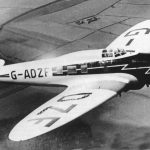In our ongoing series Today in Aviation History, we discuss the first flight and the later significance of one of the US Navy’s unsung heroes of the Cold War, the Grumman S-2 Tracker, the first purpose-built, single airframe anti-submarine warfare (ASW) aircraft developed for American carrier operations, which made its first flight on December 4, 1952. Prior to the design of the S-2, the task of hunting enemy submarines often fell to naval aircraft that were not intended for such a purpose but modified to get the job done. In WWII, this role was carried out in the US Navy by the Consolidated PBY Catalina and the Grumman TBF Avenger, but by the time the Korean War broke out, the Navy had already accepted its first aircraft built for ASW, the Grumman AF Guardian. However, due to the limits of the technology of the day, the Navy had to fly two different versions of the Guardian; a “hunter” variant fitted with ventrally mounted radome for an airborne radar unit and electronic countermeasures, and a “killer” variant with the armament necessary to destroy hostile submarines.
The Navy sought to have an aircraft that could combine the roles of hunter and killer, which would free up deck space to store, launch, and recover a single aircraft that had the means to detect and eliminate submarines. Thus, the Grumman Aircraft Engineering Corporation laid out the design for an aircraft internally referred to as the Model G-89, which consisted of a high wing monoplane powered by two Wright R-1820 Cyclone radial engines, and a crew of four. Originally designated as the S2F, the Tracker first flew on December 4, 1952.

By February 1954, the Tracker entered service with the US Navy, quickly phasing out the AF Guardian. The Tracker was fitted with an internal weapons bay for two torpedoes or a nuclear depth charge, along with six wing-mounted hardpoints for rockets, naval mines, and additional depth charges. A retractable radome was ventrally mounted to the Tracker, along with an extendable rear-mounted boom containing a Magnetic Anomaly Detector (MAD). The Tracker also came equipped with Electronic Support Measures (ESM) to “listen” to radiated electromagnetic energy and with an Autolycus (nicknamed “sniffer”), a device to detect emissions from diesel-electric submarines using a snorkel for their diesel engines while submerged.
Additionally, a 70 million candlepower searchlight was installed in the right wing, and the aircraft could jettison sonobuoys, along with smoke dispensers and explosive charges to create sound pulses for semi-active sonar units. Because of the aircraft’s designation under the Navy’s pre-1962 system for identifying aircraft, the crews who flew on and supported the S2F/S-2 Trackers gave the plane its nickname; the “Stoof.”
Additionally, the S2F (later redesignated as the S-2 in 1962) would provide a basis for two other aircraft flown in the US Navy; the C-1 Trader (called the TF Trader under the pre-1962 designation system), which was used for carrier onboard delivery (COD), and the E-1 Tracer (originally designated as the WF Tracer), the first purpose-built airborne early warning and control (AEW&C) aircraft for carrier operations. Due to the large radar unit mounted on the top of the E-1, the aircraft was the “Stoof-with-a-roof.”
In addition to its service with the US Navy (and to a limited extent, the US Marines), the S-2 Tracker was widely exported to US allies around the world, even flying off of their respective aircraft carriers. These included the armed forces of Argentina, Australia, Brazil, Canada, Italy, Japan, Netherlands, Peru, South Korea, Taiwan, Thailand, Turkey, Uruguay, and Venezuela. The Argentine Trackers would participate in the Falklands War, looking for British submarines while operating from the carriers ARA Independencia and ARA Veinticinco de Mayo (Twenty-fifth of May), which were ironically British-built WWII-era carriers.
However, the Argentine Trackers would later operate from shore installations following the sinking of the Argentine cruiser General Belgrano. With the retirement of the last of the Taiwanese turboprop-powered S-2s, the Argentine Naval Aviation branch remains the last military to maintain the Tracker in active duty, though their Trackers have also had their R-1820 radials swapped for modern turboprop engines. The last S-2 Trackers in service with the US Navy were retired in 1976 in favor of the Lockheed S-3 Viking, while the C-1 Traders have been replaced by the Grumman C-2 Greyhound and the Bell-Boeing V-22 Osprey, and the E-1 Tracer has been supplanted by the Grumman E-2 Hawkeye.


While the Grumman S-2 Tracker is, for the most part, retired from military service, the aircraft would find a new role as a civilian fire-fighting aircraft. During the 1970s, forestry services in the U.S. and Canada looked to the S-2 Trackers leaving active duty as replacements to the array of surplus WWII aircraft such as Boeing B-17 Flying Fortresses and Douglas A-26 Invaders that were now becoming old airplanes that were wearing out. Thus, the Canadian company Conair and the California Department of Forestry and Fire Protection (CAL FIRE) began modifying S-2 Trackers to become aerial firefighters, with the Conair examples being renamed the Conair Firecat.
Today, many of these aircraft have had their piston engines swapped out for modern turboprop designs such as the Pratt & Whitney Canada PT6s and Garrett/Honeywell TPE331 and have had their cockpit avionics upgraded to modern standards. Many of these conversions were carried out by Marsh Aviation of Mesa, Arizona, which was also contracted to convert the Argentine Navy S-2s to turboprops as well. Despite their new peacetime role being different than their intended one, it is still a testament to the Grumman “Iron Works” that this product of theirs remains in active use some 72 years later.
Today in Aviation History is a series highlighting the achievements, innovations, and milestones that have shaped the skies. All the previous anniversaries are available HERE

































